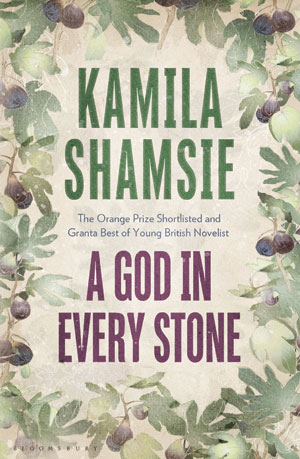|
|
The South
Asian Life & Times - SALT |
|
|||
|
Contents Adventure
Art
-
Dongria Kondh
|
|
||||
|
A God In Every Stone
By Kamila Shamsie
Reviewed by Anita Yadav
A God In Every Stone surprises the reader by its spiral narrative movements
along historical periods ranging from 515 B.C to 1947. In the opening
narrative about Sylax from The Histories by Herodotus, there is use of free
verse to convey topographical details and movement
“down the sloping desert
of the mountain across the jewelled valley
of streams and fields and fruit to land! In the muddled
tributary...........the crocodile filled Indus “
The reader feels as if an enchanted journey has begun.
References to great story tellers are drawn to
make us feel that a great tale is being told. Vivian Rose, one of the
central characters in the novel, easily quotes from Pliny, Aelian, Syclax,
Herodotus. She invokes Homer’s description of “a rosy fingered dawn’ as she
watches the sunrise on the first day of her journey in Labauranda. As we
progress, Vivian Spencer draws on
works of all travellers .The Street of
Story tellers and the genre of Daastan Goi become the backdrop to later
events involving Najib and Qayyum Gul, Viv , Diwa and the Khudai
Khidmatgars.
Kamila Shamsie has done deep research to effectively juxtapose Greek history
with Gandhara art and history. Her characters straddle ancient history,
World War I and the movement by Abdul Ghaffar Khan while trying to come to
terms with their changing lives. Her work is reminiscent of another writer
from the subcontinent-Amitav Ghosh , whose works show similar scholarly
workmanship. Reading A God In Every Stone is learning about archaeological
and social-political history too.
The book is remarkable in its use of imagery and
symbols. The figs and olives of the time with Tashin Bey, and the rotting
flesh and metals of the hospitals in London give way to the fragrance of
jasmines and roses of Peshawar and the severed limbs and lorries filled with
bodies of rebellious Pathans. Tashin Bey’s emphasis of putting loyalty to
the people he loves above loyalty to the crown is reverberated in Quyyum and
Kalaam. Vivian rose was brought up as a son and tried to do what a son
could. Diwa, a burqa clad
teenager is able to achieve what Vivian
could not. Najeeb carries the mantel of Tashin Bey in his search for the
Circlet of Syclax. Kamila Shamsie effectively binds the narrative even
though it straddles across thousands of centuries. Reading the book is like
a journey across time.
|
|||||
|
Copyright © 2000 - 2014 [the-south-asian.com]. Intellectual Property. All rights reserved. |
|||||
